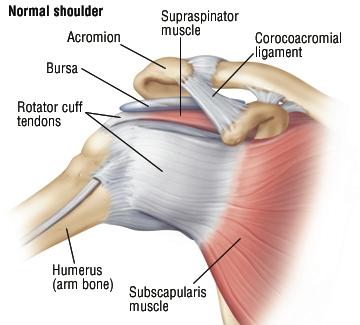Rotator Cuff Tear
The shoulder consists of three bones (humerus, scapula, and clavicle). It is a ball and socket joint that is stabilized by a group of muscles/tendons that attach around the head of the humerus called the rotator cuff. The rotator cuff stabilizes the shoulder joint. It is also helps the rotator and lifts the arm. A shoulder bursa lies between the rotator cuff and acromion bone (top of shoulder). This sac of tissue provides a smooth surface for tendon gliding.

Rotator cuff injury
Rotator cuff injuries are not uncommon. Injury to the rotator cuff may result from an acute injury, occur in conjunction with another shoulder injury or may be the result of gradual degenerative charges such as increased age, repetitive stress/motion, poor blood supply to the tendons or shoulder impingement.
Injuries may range from an inflammatory condition to partial or full thickness tears.
The shoulder bursa may become inflamed or injured which can also contribute to shoulder pain and/or loss of motion. This can occur independent to, or along with, injury to the rotator cuff.

Impingement Syndrome
Thickening of the rotator cuff and its bursa can lead to an impingement syndrome. The impingement syndrome is when tissue impinges against the bones and around the shoulder. This will cause pain.
Symptoms:
Not all rotator cuff tears are painful. However, when symptomatic, patients may experience shoulder pain at night and at rest, pain with lifting or lowering the affected arm and weakness, particularly with lifting and rotation of the arm. Overhead activities may exacerbate symptoms.
Diagnosing rotator cuff injuries:
Along with detailed history and physical exam, xray imaging and MRI may be used to determine your diagnosis.
Treatment options:
Treatment options for rotators cuff injury vary. Rest, ice and anti-inflammatory medication is usually a first line conservative approach. Physical therapy and steroid injection may also be utilized. If symptoms do not resolve with conservative treatment, surgery may be indicated. Surgery may be performed via arthroscopic or open technique. The goal of surgery is to repair injury and/or identify and resolve underlying inflammation or pathology.
Your provider at OAM will review and discuss the appropriate course of treatment with you during your office visit.


